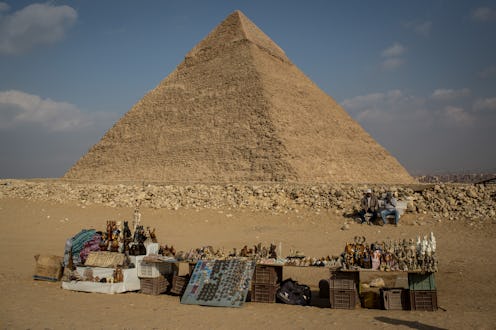Life
One Of The Great Pyramids Has A Huge Void Inside Of It That No One Knew About Until Now

2017 may be an ever-worsening trash fire, but at least some science is still pretty cool. According to NPR, scientists just discovered a huge hidden hole in the Great Pyramid of Giza, and no one knows why it's there.
The known specifics about the space, which according to NPR is the "first significant internal structure found within the Great Pyramid since the 19th century," are pretty slim. First, according to the discovery's announcement report in the journal Nature, it's located above a "tall, cathedral-like room known as the Grand Gallery," NPR reported. The newly discovered aspect, which scientists found by using a technique similar to an X-ray, is about the same size as the Grand Gallery, so around 100 or so feet long.
And that's it. Mehdi Tayoubi, one of the scientists who discovered the space, explained in a press briefing, "What we are sure about is that this big void is there, that it is impressive, and that it was not expected by any kind of theory."
For folks who are dreaming about alien tech or mummy curses, though, Harvard University Egyptologist Peter Der Manuelian (who was not involved in the discovery) has some words of caution. "The romantic interpretation and what everyone wants to hear is that this is a hidden room and the king's body is inside or there's grave goods we didn't know about or we're going to learn more about history... and none of that is responsible speculation at the moment," he told NPR.
But despite the fact that the reasons for the void's existence may well turn out to be banal, it's hard not to wonder what could be hidden there, if it could unlock more secrets about how the pyramids were built, and how exactly it remained hidden through hundreds of years of archaeological study.
The fact that we're only now discovering it could be due to the fact that researchers were using highly advanced technology when they detected the space. In deciding how best to approach investigating the pyramid on a deeper level, Tayoubi and his colleagues knew they wanted to use "the best available non-destructive analytical techniques," he told NPR. They ended up settling on using tracking particles called "muons."
The Verge laid out a succinct, easy to understand, and extremely radical-sounding explanation of muons: "Muons are produced when the cosmic rays that permeate our Universe and pummel our atmosphere break down — creating a kind of subatomic confetti that rains down on Earth at almost the speed of light."
Scientists can use this "subatomic confetti" to see inside structures because muons can move more easily through plain ol' air than through solid objects. Other investigations using muons have studied the insides of volcanoes and nuclear reactors at Fukushima, so when Tayoubi and his team installed sheets of muon-detecting film in the Queen's Chamber, inside the Great Pyramid, they were trying to test whether or not they could accurately use muons to "see" two already-discovered rooms above the Queen's Chamber.
Finding the new space was a happy accident, and the unexpected discovery could provide clues that will help archaeologists solve the pyramid's other mysteries.
The more research is revealed about the Great Pyramid, the more Egyptians' thoroughly natural architectural processes come to light. Another recent study, revealed in September 2017, shed light one of the longest-running questions about the Great Pyramid: How ancient Egyptians were able to transport building materials — which archaeologists already knew had been quarried 533 miles away — to its site. According to the information revealed in September 2017, materials were transported by boat, and definitely not by UFO.
As for discovering more about the mystery void, Tayoubi told NPR that moving forward is going to involve teamwork. "I think it's now time for Egyptologists and specialists in ancient Egypt architecture to collaborate with us, to provide us with some hypotheses," he said.
In the interim, laypeople of all stripes are sure to come up with hypotheses of their own.